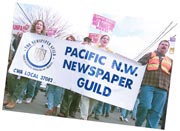The Detroit newspaper strike was about one month old and the unions were rallying the troops. W. Kim Heron, then a copy editor for the Detroit Free Press, remembers well the pep talk by national labor leader Richard Trumka. “He was saying, ‘We showed them in this strike and in that strike,’ and he kept giving the length of the strikes,” says Heron. And each strike seemed to have a longer duration than the last. Finally, Trumka cited a six-year-long strike.
“I said, ‘Yeah!'” recalls Heron, “and then turned to somebody next to me and said, ‘Six years?'”
It turns out the union boss was off by less than a year; some 2,500 employees of the Detroit News and Detroit Free Press walked off the job in July 1995; contracts with the last unions affected were ratified just last month. Although many staffers actually returned to their jobs in early 1997, Heron was not among them. He’s now the managing editor for Metro Times, a Detroit alternative weekly.
Detroit’s five and a half years of picket lines, boycotts, and court battles has loomed large—both as worst-case scenario and valuable learning experience—as Seattle’s two dailies have weathered a 48-day strike by the Pacific Northwest Newspaper Guild.
The Detroit strike’s most visible influence has shown itself in the chain-link fences, plywood-covered windows, and black-clad security officers at The Seattle Times (many employed by Vance International Security Services, a major contractor for the two Detroit newspapers during their strike).
Times Executive Editor Mike Fancher acknowledged early in the strike that the martial air of his paper’s response hurt the paper’s image, but added that violent incidents during other recent newspaper work stoppages made such measures necessary. “If you think about what can happen in an emotional situation like a strike, you have an obligation to your working employees that they feel that they’re not at risk,” he says. “This is
Seattle, it’s not Detroit—but you can’t know in a case like this.”
But Seattle strikers also saw the influence of the Detroit strike in the Times‘ meticulous preparation. After the walkout, strikers found their company-issued cell phones had been turned off and their computer passwords disabled. Meanwhile, the skeleton crew of editors and a few nonstriking workers got free lunches and rental cars.
“So the people inside—although they were working their asses off—really felt they were being taken care of,” says one Times newsroom striker.
Guild spokesperson Ron Judd, a Times columnist, says his organization learned a lot of lessons from the Detroit strike, most importantly, the value of a strong strike paper. The Seattle Union Record, written and edited by staffers from the Times and Seattle Post-Intelligencer (whose employees approved their contract on December 28), established an online presence immediately after the walkout and had a thrice-weekly paper edition on downtown streets within a week.
Judd points out that the Detroit strikers didn’t get their strike paper out until several months into the strike. He adds that that paper, the weekly Detroit Sunday Journal, drew public criticism for focusing too closely on union issues and the strike itself. The goal in Seattle was to create a paper that could function as an aboveboard, unbiased news source—a true competitor to the trimmed-down strike editions of the Times and P-I.
Larry Gabriel, a former Free Press feature writer and current Metro Times editor, agrees that the unions waited too long to establish a strike paper. “Personally, I feel that was one of the biggest mistakes as far as keeping people from crossing the [picket] line,” he says. “I think if we’d had a strike paper from day one, we’d have been able to get our message out to the public a lot better, and it would give people who are journalists an outlet for their skills.”
A strong, well-executed strike paper is a sign of organizational strength and the resolve of strikers, adds Heron, who served for a time as the Sunday Journal‘s managing editor. “We were not able to send that message for quite a while.” A strike paper also aids in an advertising and subscription boycott by giving advertisers and readers a choice, he notes.
The Detroit Sunday Journal‘s strike-oriented content was partly influenced by the several unions that participated in the strike and paid for the paper’s printing. Here, only the Newspaper Guild went on strike, so editorial staffers had a heavier influence on the content of the Seattle Union Record.
One final effect of the Detroit strike was to bring home the consequences of a lengthy labor dispute. When the strike commenced, the two papers (which, like the Times and P-I, operate under a joint operating agreement) had a combined daily circulation of 900,000 and a Sunday circulation of 1.1 million. Currently, circulation of the two Detroit papers stands at 604,000 daily and 750,000 on Sundays.
With sobering figures such as these, it’s not surprising that local Guild leaders recommended approval of the company’s most recent contract offer. “If you hold out for another six months and get an extra 15 cents per hour,” says Judd, “you haven’t really gotten anything.”






